1. Hidden Penguin Colony Discovered
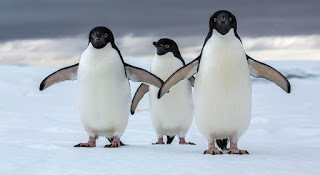 Satellite images have revealed the existence of hidden mega-colonies of Adelie penguins on Antarctica’s Danger Islands. The discovery of another 1.5 million penguins boosts the population of Antarctic penguins by nearly 70 percent. Although warming oceans are melting the sea ice on the western side of the Antarctic Peninsula, the new colonies are safe for now on the eastern side, where the ice lasts longer and creates better conditions for chick production. The discovery strengthens the argument for creating a new marine protected area that would include a 30-km buffer around Antarctica’s penguin colonies. That’s a cool idea in a region where “sea ice-free seasons have lengthened by up to three months; nearly 600 of the region’s 674 glaciers are in retreat.”
Satellite images have revealed the existence of hidden mega-colonies of Adelie penguins on Antarctica’s Danger Islands. The discovery of another 1.5 million penguins boosts the population of Antarctic penguins by nearly 70 percent. Although warming oceans are melting the sea ice on the western side of the Antarctic Peninsula, the new colonies are safe for now on the eastern side, where the ice lasts longer and creates better conditions for chick production. The discovery strengthens the argument for creating a new marine protected area that would include a 30-km buffer around Antarctica’s penguin colonies. That’s a cool idea in a region where “sea ice-free seasons have lengthened by up to three months; nearly 600 of the region’s 674 glaciers are in retreat.”
Read More…
—————————————————
2. Rare Good News for Sharks and Rays
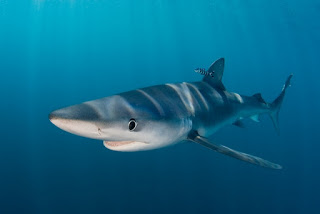 More than a third of the world’s sharks and rays are threatened with extinction, but this week brought rare good news. Hong Kong boosted its penalties for those convicted of illegally selling or buying products derived from CITES-listed endangered species. The maximum sentence was raised from 2 years to 10, and maximum fines soared from $6,400 to $1.3 million. According to the Pew Charitable Trusts, some 63 to 273 million sharks “are killed every year, mainly solely for their fins, which are used primarily to make shark fin soup.” Read More…
More than a third of the world’s sharks and rays are threatened with extinction, but this week brought rare good news. Hong Kong boosted its penalties for those convicted of illegally selling or buying products derived from CITES-listed endangered species. The maximum sentence was raised from 2 years to 10, and maximum fines soared from $6,400 to $1.3 million. According to the Pew Charitable Trusts, some 63 to 273 million sharks “are killed every year, mainly solely for their fins, which are used primarily to make shark fin soup.” Read More…
—————————————————
3. Marine Sanctuaries Boost Fish Production
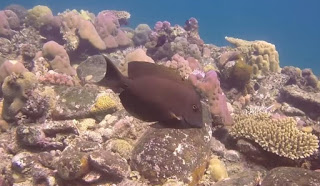 A recent study provides the latest evidence that marine protected areas can boost fish stocks and size. The study of three fish species around coral reefs in the Philippines found that “fish born in marine reserves where fishing is prohibited grow to be larger, healthier and more successful at reproduction.” Although many MPAs are closed to fishing, the larger fish replenish stock in areas where fishing is permitted. “The more robust fish naturally migrate from the MPAs to the fished areas, where they can be harvested by fishermen.”
A recent study provides the latest evidence that marine protected areas can boost fish stocks and size. The study of three fish species around coral reefs in the Philippines found that “fish born in marine reserves where fishing is prohibited grow to be larger, healthier and more successful at reproduction.” Although many MPAs are closed to fishing, the larger fish replenish stock in areas where fishing is permitted. “The more robust fish naturally migrate from the MPAs to the fished areas, where they can be harvested by fishermen.”
 West Coast sardine fishing has been closed for the fourth year in a row. “The northern Pacific sardine population, stretching from Mexico to British Columbia, has plummeted 97% since 2006, according to an assessment released this week by the National Marine Fisheries Service and the Pacific Fishery Management Council.” John Steinbeck’s classic novel Cannery Row is set against the backdrop of Monterey’s sardine canning plants.
West Coast sardine fishing has been closed for the fourth year in a row. “The northern Pacific sardine population, stretching from Mexico to British Columbia, has plummeted 97% since 2006, according to an assessment released this week by the National Marine Fisheries Service and the Pacific Fishery Management Council.” John Steinbeck’s classic novel Cannery Row is set against the backdrop of Monterey’s sardine canning plants.—————————————————
5. Mass Starfish Strandings Along the English Coast
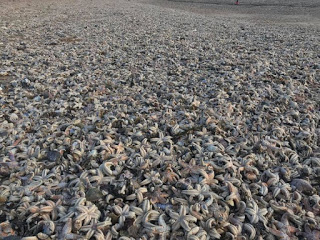 Thousands of starfish washed up dead along the English coastlines of Kent and East Yorkshire. The “Beast from the East” polar vortex, which brought below-freezing temperatures and high winds, is being blamed for the strandings. Behavior known as “starballing,” in which starfish roll up in a ball to travel farther along the seafloor, may have helped them to be carried to shore by high winds and waves. The die-off isn’t a threat to the species, though. According to marine biology lecturer Coleen Suckling, “starfish are resilient, abundant, and widespread in the Atlantic.”
Thousands of starfish washed up dead along the English coastlines of Kent and East Yorkshire. The “Beast from the East” polar vortex, which brought below-freezing temperatures and high winds, is being blamed for the strandings. Behavior known as “starballing,” in which starfish roll up in a ball to travel farther along the seafloor, may have helped them to be carried to shore by high winds and waves. The die-off isn’t a threat to the species, though. According to marine biology lecturer Coleen Suckling, “starfish are resilient, abundant, and widespread in the Atlantic.” —————————————————
6. Florida “Super Corals”
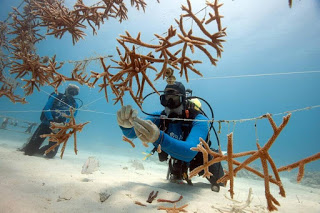 Scientists at a Miami laboratory have bred corals that they hope will be more resilient to warming seas. In the coming months, they will plant them on reefs off Key Biscayne and Miami Beach, where 90 percent of staghorn coral has died off. Hardier, more heat-tolerant algae was bred into the lab corals from specimens that recovered after a bleaching event. This is one of several coral restoration projects underway worldwide. “In the [Florida] Keys, Mote Marine Lab has 20,000 corals, and in 2016 it struck a 15-year deal with the Nature Conservancy to build gene banks and begin transplanting more than 1 million in the Keys in the Caribbean.”
Scientists at a Miami laboratory have bred corals that they hope will be more resilient to warming seas. In the coming months, they will plant them on reefs off Key Biscayne and Miami Beach, where 90 percent of staghorn coral has died off. Hardier, more heat-tolerant algae was bred into the lab corals from specimens that recovered after a bleaching event. This is one of several coral restoration projects underway worldwide. “In the [Florida] Keys, Mote Marine Lab has 20,000 corals, and in 2016 it struck a 15-year deal with the Nature Conservancy to build gene banks and begin transplanting more than 1 million in the Keys in the Caribbean.”Be sure to “LIKE” http://facebook.com/SeaSave to ensure our “Week in Review” is delivered to your newsfeed every Friday.
Sea Save Foundation is committed to raising awareness of marine conservation. The Week in Review is a team effort produced by the Sea Save staff to provide a weekly summary of the latest in marine research, policy, and news.




